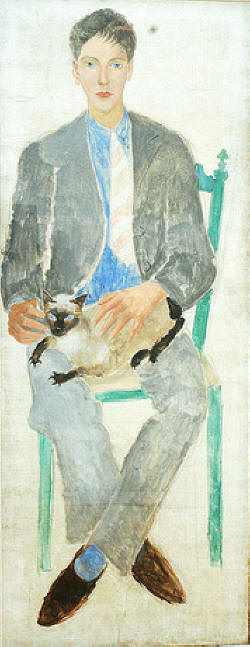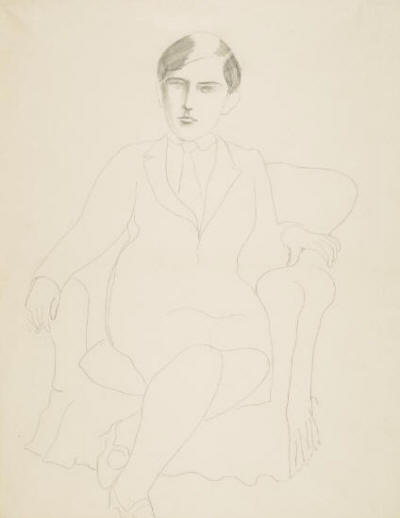

Queer Places:
3 Rue Rodier, 75009 Paris, France
 Jean Bourgoint (June 25, 1905 - March 11, 1966) was of astonishing good
looks and sweetness of nature. Older, he found his vocation and became a
Cistercian lay-brother: Brother Pascal. Jean Cocteau always remained in touch
with him and had the benefit of his prayers. After Cocteau's death, this was
not enough: the man who had been one of Les Enfants terribles insisted on
being sent to the poorest of leper colonies in Africa, to serve until he died.
Jean Bourgoint (June 25, 1905 - March 11, 1966) was of astonishing good
looks and sweetness of nature. Older, he found his vocation and became a
Cistercian lay-brother: Brother Pascal. Jean Cocteau always remained in touch
with him and had the benefit of his prayers. After Cocteau's death, this was
not enough: the man who had been one of Les Enfants terribles insisted on
being sent to the poorest of leper colonies in Africa, to serve until he died.
Jean Bourgoint was a French Catholic cleric born on June 25, 1905 in Montmartre and died in Garoua on March 11, 1966. Les Enfants terribles, Jean Cocteau's 1929 novel and later adapted for film by Jean-Pierre Melville, was largely inspired by the life of the Bourgoint family and in particular that of Jean Bourgoint and his sister, Jeanne Bourgoint. Their roles were performed on screen, respectively, by Édouard Dermit and Nicole Stéphane. Jean Bourgoint was for a time the intimate of Jean Cocteau, Jean Hugo and Jacques Maritain. Having become a Trappist brother under the name "Brother Pascal", he went to Cameroon to treat lepers. Today, Jean Bourgoint is best known for being with his sister the "hero in spite of himself" of Jean Cocteau's novel The Terrible Children, under the name of Paul, and the "Terrible Child" is the nickname that remained to him. Her sister, Jeanne (Elisabeth in Cocteau's work), was a model. As in the novel, she committed suicide when she was only in her twenties. Jean Bourgoint also bed famous for having been a kind of father to Charles de Foucauld in his own way, leaving France to go like his eldest to Africa, more precisely to Mokolo, Cameroon, to care for lepers. He was taken away by cancer on March 11, 1966 and buried in the country he wanted to make his own.
Jean Bourgoint was born in 1905, on Rue Rodier in Paris in the 9th arrondissement after the twins Jeanne and Maxime. Jean Bourgoint referred to "the beloved bag of Rue Rodier" that, in fiction, Jean Cocteau preferred to relocate Cité Monthiers to the district of Petit Lycée Condorcet, which was more familiar to him. From 1922, he led an idle life and frequented a lot Le bœuf sur le toit (Of Beef on the Roof). In 1925, he met Jacques Maritain and Jean Cocteau. The latter communicated with Jean Bourgoint and Maurice Sachs at his side. Jean Bourgoint and his sister Jeanne discover opium. He received baptism at Meudon in the private chapel of the Maritains. In October, he made a stay at the abbey of Solesmes. In 1929, his sister Jeanne committed suicide, which he never really recovered from. Jean Cocteau published his novel The Terrible Children the same year. Between 1930 and 1936, he met Jean Hugo, who then hosted him at the Mas de Fourques in the Gard next to Lunel, where he returned several times, made a stay at the Trappe d'Aiguebelle in the Drôme and then returned to Fourques where Jean Cocteau and Marcel Khill stayed. In 1946, he met Father Alex-Ceslas Rzewuski, who guided him to the Dominicans of Saint-Maximin. A long stay followed and his meeting with Georges Lauris. On December 24, 1947, he joined the Cistercians of the abbey of Cîteaux, where he became "Brother Pascal". In the 1960s, Raïssa Maritain (1960) and Jean Cocteau (1963), his friends, died. A serious crisis of doubt about his vocation will lead him to leave Cîteaux. On August 9, 1964, Jean Bourgoint moved to Cameroon at the Mokolo leprosy. On March 11, 1966, he died of cancer in Garoua, Cameroon, where he was buried according to his wishes.

Title: Portrait of Jeanne Bourgoint,
Artist: Christopher Wood, Object type: Work on paper, Materials:
Pencil on paper,
Date created: About 1925 - 1926, Measurements: 53.90 x 42.10 cm, Credit line: Presented by Jim Ede 1977
My published books: